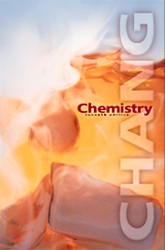|
 |  Chemistry, 7/e Raymond Chang,
Williams College
Thermochemistry
Internet ExercisesTriptik for thermochemistry
(http://www.chem.vt.edu/RVGS/ACT/notes/Chap_8_Triptik.html)
- Calorimetry is the measurement
of heat changes of physical and chemical processes. In the laboratory, these
processes are measured in a calorimeter. The Triptik for thermochemistry at
http://www.chem.vt.edu/RVGS/ACT/notes/Chap_8_Triptik.html
contains two examples of calorimeters. Make sketches of each, and then answer
the following.
- How does
a bomb calorimeter differ from a simple coffee cup calorimeter?
- A quantity of 2.896
g of methanol (CH3OH) was burned in a constant-volume bomb
calorimeter. Consequently, the temperature of the water rose by 6.33°C.
If the quantity of water surrounding the calorimeter was exactly 1900
g and the heat capacity of the calorimeter was 2.56 kJ/°C, calculate
the molar heat of combustion of methanol.
|
 |  |  | The Chemistry Tutor
( http://tqd.advanced.org/2923/react2.html)
- The Chemistry Tutor
provides help on a variety of topics such as chemical reactions, mole/gram
conversions, equations, ideal gas laws, and lab safety. Study the information
given about combustion reactions at http://tqd.advanced.org/2923/react2.html,
and answer the following questions.
- Is combustion an
exothermic or endothermic reaction?
- Why do you think
these reactions occur mostly in automobiles, homes, and factories?
- What would you need
and do to determine the enthalpy change of a specific combustion reaction?
- Calculate the work
done by carbon dioxide if it expands from 3.50 mL to 60.0 mL against a
constant pressure of 3.30 atm.
|
|
|



 2002 McGraw-Hill Higher Education
2002 McGraw-Hill Higher Education

 2002 McGraw-Hill Higher Education
2002 McGraw-Hill Higher Education